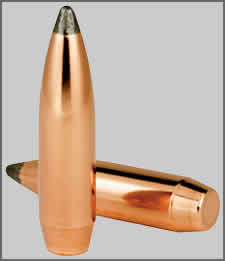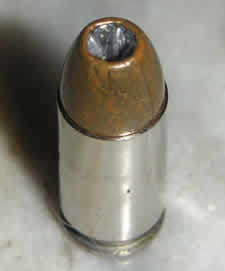Home | Glossary | Resources | Help | Contact Us | Course Map
Archival Notice
This is an archive page that is no longer being updated. It may contain outdated information and links may no longer function as originally intended.
Assembly
Bullet jackets and lead cores must be assembled to form a usable bullet.
This involves the following steps:
- Feeding the components into a machine capable of applying pressure
- Providing forming dies in the machine
- Providing a way to move parts from one station to the next
The last requirement allows progressive forming of parts in increments of pressure. Stress on the bullet is reduced by spreading the work over multiple stations.
Machinery
The most pervasive press for bullet assembly is the transfer press, which contains a shuttle device that can shift the parts sideways from one station to the next. This type of press is common to many industries that form metal parts in stages. Because the transfer press has many parts that move, it offers options for powering accessory units for special operations, such as adding a cannelure.
Bullet assembly can also be performed on a dial or rotary press. In contrast to the transfer press, parts are moved in a dial rotating on a horizontal plane.
The stages of bullet forming are similar, regardless of the press employed, and are as follows:
- A drawn jacket that is ready for the press has a rounded bottom (closed end); this assists feeding into the press.
- The jacket is fed into the press.
- If the bullet is to be a military FMJ with a sharp point, the point is coined in one or two stations before core insertion.
- If the bullet is a boattail sporting bullet, the tapered heel is formed by coining at this point.
- A tamping operation compresses the lead core into the jacket to eliminate any voids between the lead and the jacket. This also holds the core in the jacket so it will not move during subsequent operations.
Open Point
The remaining operations in making an open point bullet are devoted to shaping the point. Because metal must be displaced and moved, point shaping is performed in multiple steps to avoid excessive load on the bullet and/or the equipment. The point starts by forming a truncated cone in which the lead in the core is squeezed up toward the open end of the jacket. The next die begins the transition to a curved surface called the ogive. The first die starts to round the profile of the ogive; a second or third die finishes forming the pointed shape.
Full Metal Jacket
An essential requirement for the making of a FMJ bullet is that the base is closed after the core is tamped. A small amount of jacket material protrudes beyond the tamped lead core and is folded over the core. This is accomplished in two operations. Folding begins by coning the rear edge of the jacket; a base-finishing die flattens the base.
Additional Online Courses
- What Every First Responding Officer Should Know About DNA Evidence
- Collecting DNA Evidence at Property Crime Scenes
- DNA – A Prosecutor’s Practice Notebook
- Crime Scene and DNA Basics
- Laboratory Safety Programs
- DNA Amplification
- Population Genetics and Statistics
- Non-STR DNA Markers: SNPs, Y-STRs, LCN and mtDNA
- Firearms Examiner Training
- Forensic DNA Education for Law Enforcement Decisionmakers
- What Every Investigator and Evidence Technician Should Know About DNA Evidence
- Principles of Forensic DNA for Officers of the Court
- Law 101: Legal Guide for the Forensic Expert
- Laboratory Orientation and Testing of Body Fluids and Tissues
- DNA Extraction and Quantitation
- STR Data Analysis and Interpretation
- Communication Skills, Report Writing, and Courtroom Testimony
- Español for Law Enforcement
- Amplified DNA Product Separation for Forensic Analysts




